A History of the County of Berkshire: Volume 4. Originally published by Victoria County History, London, 1924.
This free content was digitised by double rekeying. All rights reserved.
'Parishes: Appleton', in A History of the County of Berkshire: Volume 4, ed. William Page, P H Ditchfield (London, 1924), British History Online https://prod.british-history.ac.uk/vch/berks/vol4/pp335-341 [accessed 31 January 2025].
'Parishes: Appleton', in A History of the County of Berkshire: Volume 4. Edited by William Page, P H Ditchfield (London, 1924), British History Online, accessed January 31, 2025, https://prod.british-history.ac.uk/vch/berks/vol4/pp335-341.
"Parishes: Appleton". A History of the County of Berkshire: Volume 4. Ed. William Page, P H Ditchfield (London, 1924), British History Online. Web. 31 January 2025. https://prod.british-history.ac.uk/vch/berks/vol4/pp335-341.
In this section
APPLETON
Æppeltune, Appeltun, Earmundes-læh,-leah,-lee,lei (x cent.); Apletone, Apletune, Appelton (x–xvii cent.); Aspelton (1316).
The ecclesiastical parish forms the civil parish of Appleton with Eaton; it is bounded on the west and north-west by the Thames and on the east by a branch of the Ock. The most valuable fishery in the county in 1086 was that at Appleton, (fn. 1) which was worth £1 4s. 2d., (fn. 2) and there were three others at Eaton. (fn. 3) Attached to the manor of Appleton in 1610 was a fishery in the Thames called Pollard's Castle, extending for a mile (1,000 passus). (fn. 4) This stretch is still a favourite haunt of anglers.
The village of Appleton, 6 miles south-west of Oxford, lies at a height of about 300 ft., the ground sloping gently down to the Thames, the banks of which are here about 200 ft. above the ordnance datum. At the meeting-place of the four cross-roads on which the village is built stand the Plough Inn and the pound. There are two establishments of hurdle-makers and one for the manufacturing of turret clocks, brass-founding and bell-hanging.
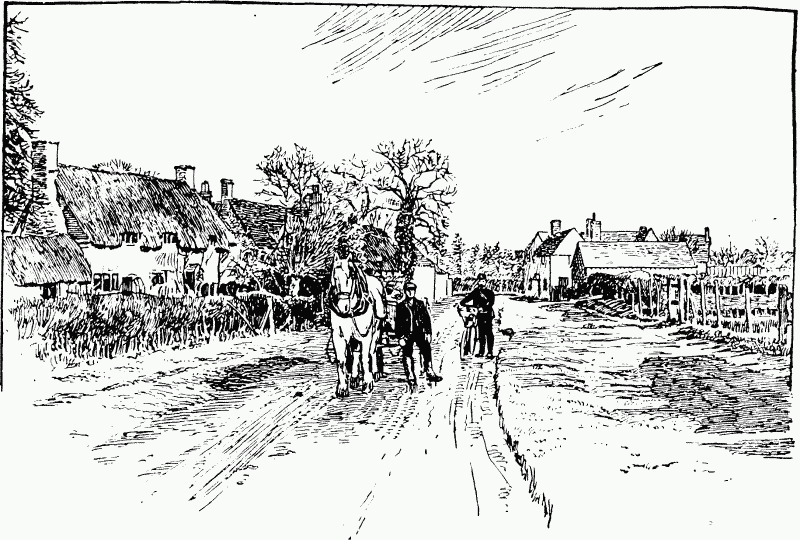
Appleton: A View In The Village
The Manor House, south of the church, is surrounded by a dry moat, still complete on three sides. The house is of great interest as an early example of domestic work, and was built about 1200, altered in the late 16th century, and entirely refaced outside within the last few years. In the centre of the entrance front, which is covered with modern roughcast, is a timber-framed porch, probably Elizabethan. The great hall has been divided into an entrance hall, a large room, and a corridor. It is entered by an original doorway within the porch of three recessed and moulded orders of semicircular form, and having a label and side shafts, two of which are lost. The shafts have carved foliage capitals and circular abaci. In the end wall of the hall, behind the former screens, are two round-headed doorways of the same date and of one chamfered order with moulded imposts and labels. The ceiling bears the initials R.S., and the room partitioned off from the hall has good panelling of about 1700 and traces of a large fireplace. The drawing room above it has a stone four-centred fireplace of Tudor character with a carved oak overmantel with Ionic pilasters. The walls are covered with Elizabethan panelling. Adjoining the screens end of the hall is a room with good deal panelling and ceiling cornice of about 1700.
On the death in 1435 of William Fitz Warin, the lord, his widow Elizabeth was given as dower a small house called Deyhow, 'Dowery Berne' near 'le Colnhows,' the middle stable, the west garden and a wood called Longewode, with other lands. (fn. 5)
Tinteyns Manor House, now divided into tenements, is a rectangular stone building of Elizabethan date, but possessing few features of interest. The north front has a five-light transomed window of oak with an oak lintel and a similar four-light window above it. The square-headed door has a moulded frame. In the centre of the building is a large stone chimney stack with brick shafts set diagonally. The former moat has been filled in.
Two houses in Appleton were licensed for Baptist meetings in 1672. (fn. 6) There is a small Wesleyan chapel here and an elementary school endowed in 1709 by Thomas Lane and others. The Church of England School, built in 1837 and enlarged in 1869, stands upon what was once the green. A village feast was formerly held on the Sunday and Monday after 21 August (Feast of St. Lawrence, old style).
Eaton, about a mile to the north, is composed of the Manor Farm and a few scattered houses.
The area of the parish is 2,077 acres, of which 18 acres are covered by inland water, 909 acres are arable land, 804 permanent grass and 263 woods and plantations. (fn. 7) The subsoil is Oxford Clay and Corallian Beds, the soil loam and clay, and the chief crops are wheat, oats, barley, beans and roots. Under an Act of 1828 (fn. 8) 1,500 acres in Appleton were inclosed in 1831, (fn. 9) when the following 'old inclosures' are mentioned: Eaton Heath, the Top of New Ground, Maid's Close, the Copse, Crab Tree Close, Common Close. (fn. 10) In the 10th-century boundaries of Appleton occur: Docca's grove, Hazel-lea, the River Was, Tubba's ford, the street, the row, (fn. 11) Yttings Hlaw. (fn. 12) Many of them have been identified with existing places. (fn. 13) The names Mootfield, Nickey Nims, Saints Hill and Swan Heath are still in use. Badwell, a spring with a stone vault and basin, is accounted good for the eyes.
Edmund Dickinson, M.D. (1624–1707), alchemist and Court physician under Charles II and James II, was son of the Rev. William Dickinson, rector of Appleton. (fn. 14) William White (1604–78), the divine, was appointed rector in 1662. (fn. 15)
Manors
The whole of this parish seems at an early date to have formed part of Æaromundeslee,' but by the 10th century the name of APPLETON was already applied to the vill. (fn. 16) Although little credence can be given to the charters relating to the early history of Abingdon Abbey, it seems not improbable that land here was actually given by Cissa, an under-king of the West Saxons, to Hæha, the traditional founder of the abbey, at some time during the 7th century. (fn. 17) When the house was devastated by the Danes in 871 Æaromundeslee also fell into their hands (fn. 18) but it must have been recovered by Alfred the Great, and the part called Appleton was granted by King Edmund in 942 to his thegn Athelstan, (fn. 19) by whom it was said to have been restored to the house of Abingdon. (fn. 20) No later authentic record of its possession by the abbey has, however, been found. (fn. 21)
In 1086 (fn. 22) both Appleton and Eaton were in the fee of Miles Crispin, one Richard holding under him in Appleton land previously assessed at 5 hides and then at 2½ hides, and held by Halden before the Conquest. (fn. 23) Another fee at Appleton of the same assessment was held in 1086 by Berner, nephew of R. de Peroue, of the Bishop of Bayeux's fee. (fn. 24)
With other lands of Miles Crispin both Appleton and Eaton were afterwards members of the honour of Wallingford (q.v.), doing service at the court leet there once a year. (fn. 25)
Under the lords of Wallingford the family of Visdelou (Visus Lupi) is found as mesne tenant before the end of the 12th century. The vill, which had formerly belonged to the mother of Humphrey Visdelou, was in the hands of the Crown as guardian of the heir from 1185 to 1189, (fn. 26) and in 1190 John Visdelou paid 15 marks for 'acknowledgment' of the knight's fee held by his father in Appleton. (fn. 27) In January 1196–7 Alexander son of Richard, with his wife Eleanor, and Fulk son of Richard, with his wife Maud, granted a hide of land here to Roger son of Walkelin Visdelou for life for the service of one-fifth of a fee, with reversion on his death to the grantors. (fn. 28) In the following year Roger restored to them half a hide at Appleton. (fn. 29) Alexander son of Richard must have joined the baronial party for in 1215 King John granted his land here to Roger de Haya during pleasure. (fn. 30) In 1218, however, Humphrey Visdelou, son of Alexander and Eleanor, paid relief for half a knight's fee in Appleton. (fn. 31) Humphrey Visdelou was succeeded by William his son, possibly identical with the William Visdelou who paid scutage in this county in 1305. (fn. 32)

Visdelou. Argent three wolves' heads sable cut off at the neck.
In Appleton, as in Abington, Northamptonshire, a tenancy was held under the Visdelous by the family of Rycote of Rycote co. Oxon., the tenancy in demesne being in the hands of William de Merton in 1240–1. (fn. 33) In 1428 John de Werynge was the tenant of this fee (fn. 34); its further descent has not been traced.
The other moiety, afterwards the manor, of Appleton had passed by the beginning of the 13th century to a family taking its name from the place. A return of king's escheats at that time mentions 57 solidates of land which Mabel de Appleton held of the king in Appleton. (fn. 35) This was evidently the land formerly belonging to Geoffrey de Appleton, whose heir should have been in the king's custody, but the land was then in the hands of Walter de Tywa. (fn. 36) Geoffrey de Appleton's land was granted by the Crown in 1215 to Roger de Haya. (fn. 37) Thomas de Appleton held land here in 1240, (fn. 38) and in 1269 granted 'the manor of Appleton and Eaton' to Denise de Stoke (Stokes) with the advowson of the church. (fn. 39) She and Master Robert her son held three knights' fees of the honour of Wallingford in 1293, when, having alienated them to the king, they received a regrant for life. (fn. 40) Denise was dead in 1307, when Edward II granted the reversion of this manor and the advowson of the church after the death of Robert to Giles de la Mote and Alice his wife and their issue with reversion to the Crown. (fn. 41) They received in 1309 a further grant of the fees of the manor. (fn. 42) Robert was dead in 1310. (fn. 43) Giles died seised of Appleton Manor in or before 1334, leaving a son and heir Richard, (fn. 44) who in 1340 by royal licence (fn. 45) enfeoffed James de Woodstock and Joan his wife. (fn. 46) James died seised before February 1340–1, leaving a brother and heir Stephen de Woodstock or Crotebrigg, (fn. 47) whose son Thomas in 1345 granted the reversion on the death of Joan widow of James de Woodstock to Sir William de Shareshill, afterwards lord chief justice. (fn. 48) Thomas de Missenden, to whom Joan had conveyed the manor, granted it to Sir William, (fn. 49) and the king quitclaimed all right in the reversion on account of the fruitful and laborious services of the new grantee. (fn. 50) As Giles, Thomas, Nicholas, William, Roger, Isabel and Margaret, all children of Giles de la Mote and Alice, were still alive, reversion to the Crown did not seem probable. (fn. 51) Richard de la Mote, who had taken holy orders (fn. 52), quitclaimed the manor to Joan and Sir William in 1345 (fn. 53) and William brother of Richard likewise made a quitclaim in 1347. (fn. 54) It may be suggested that these transactions were collusive with the intention of freeing the land from possible reversion to the Crown. Appleton was inherited by William de Shareshill, son of Sir William, but long before his death in 1400 (fn. 55) it had reverted to the Motes. Thomas, last of the sons of Giles and Alice died childless in 1375, when seisin of the manor and advowson was given to John Fitz Warin and Margaret his wife, daughter and now heir of Giles and Alice. (fn. 56) John died in 1401, Margaret having predeceased him. (fn. 57) On the death of their son William in 1435 the manor passed to his daughter Alice wife of John Gerald. (fn. 58) She married secondly Roger Caston (Kiston), by whom she had a son and heir John, and, thirdly, John Crofton. She died in 1446, (fn. 59) and the manor was delivered to her husband, by whom she had a son William, who predeceased her. (fn. 60) Her son John Caston died seised of the reversion in 1452, when his interest descended to William Petyt, son of Philippa granddaughter of John and Margaret Fitz Warin. (fn. 61) William seems to have died before 1456 when the wardship of his son Thomas Petyt as grandson of John Petyt lord of Evenlode (co. Worcester) was granted by the Prior and Convent of Worcester to John Gloucester. (fn. 62) Thomas died young and was succeeded by William his brother whose custody and land in Berkshire were seized in 1460 by the Prior of Worcester as overlord of Evenlode. (fn. 63) William Petyt belonged to the Yorkist party and received some favour from Edward IV. (fn. 64) He sued John Crofton for refusing to settle the reversion of the manor on himself and his wife Eleanor daughter of John Gloucester. William stated that John pleaded disseisin of the manor at the hands of a bastard called Edward Talbot alias Sprengeys, John Isbury and Thomas Denton. (fn. 65)

De La Mote. Vair a bend engrailed gules.
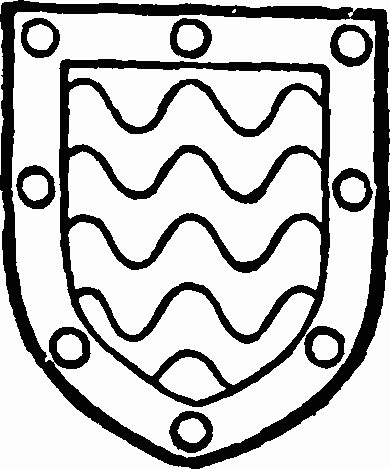
Shareshill. Barry wavy argent and gules a border sable with bezante.
The Dentons sprang from a family established at Fyfield, (fn. 66) and John Denton, who died seised of the manor and advowson of Appleton in 1497, (fn. 67) is described as of Wittenham (Wightam), Berks. (fn. 68) Thomas son and heir of John (fn. 69) was succeeded by a son John, (fn. 70) who in 1564 with Magdalene his wife conveyed this manor to John Fettiplace (fn. 71) of Bessels Leigh. The manor then descended with the lordship of Bessels Leigh (fn. 72) (q.v.), with which in 1634 it was conveyed to William Lenthall; it was in the possession of John Lenthall in March 1695–6. (fn. 73) The next mention found is in 1716, when Nathaniel Cooke and Mary his wife settled the manors of Appleton and Tynteyns on themselves. (fn. 74) In 1772 John Cooke and Elizabeth his wife conveyed the manors to Robert Southby. (fn. 75) The Southbys had long been resident at Appleton, possibly from the time when Richard Southby of Carswell (in Buckland parish, q.v.) married Jane eldest daughter of Edward Keate (fn. 76) of Lockinge, owner of a capital messuage here in 1624. (fn. 77) Richard's third son Robert, described as of Appleton, (fn. 78) was buried here in 1679. (fn. 79) His eldest son Robert died unmarried in 1717 and was succeeded by his nephew Robert, father of the Richard who was buried here in 1762 and left six sons. (fn. 80) The eldest Robert Southby, LL.D., who lived in Bedford Place, Bloomsbury, purchased the manor in 1772; he was a deputy lieutenant for Berkshire and died in 1824. His only child Anne had died in 1806, (fn. 81) and he bequeathed Appleton to Robert James Southby, second son of his brother Richard. Robert son of Robert James sold the estate, including the Manor House, in 1880 to Mrs. Weaving, whose trustees in 1912 sold it to the Rev. Charles Frederick Reeks. (fn. 82)
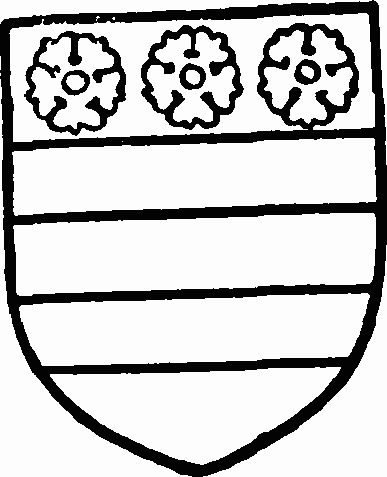
Denton. Argent two bars gules with three cinqfoils sable in chief.
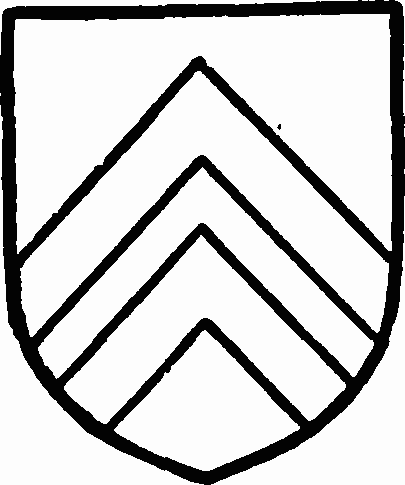
Fettiplace. Gules two cheverons argent.
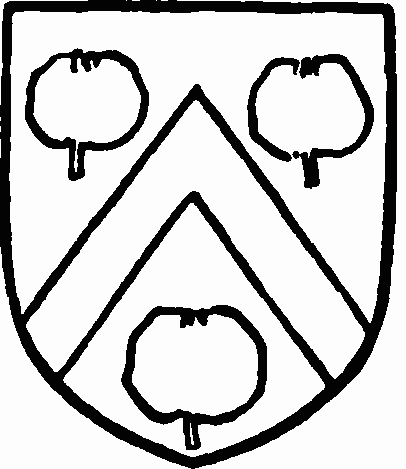
Southby. Or a cheveron between three apples gules.
EATON (Eatun, Ættuna, Eltune, Edtune, xi cent.; Etone, xiii-xv cent.) though claimed at a later date by Abingdon Abbey (fn. 83) as a member of Cumnor, (fn. 84) does not appear among the possessions of that house in any authentic charter. (fn. 85) If the tradition has any foundation in fact Eaton had been separated from Cumnor and lost to the abbey at the time of the Conquest. (fn. 86)
In 1086 Richard, tenant of part of Appleton, held of Miles Crispin 5 hides in 'Eltune' formerly held by Halden, while Alured held of Miles the 5 hides of 'Edtune' which Bosi had formerly held. (fn. 87) These two vills seem to have represented the earlier and later Eaton; each was assessed both before and after the Conquest at 5 hides. (fn. 88) Both fees afterwards became part of the honour of Wallingford. (fn. 89) One (probably Richard's) manor seems to have followed the descent of Appleton; the other holding apparently passed from Alured to his son Roger, for early in the 12th century Roger son of Alfred granted to Abingdon Abbey his tithes of Eaton, near Cumnor, and promised to persuade his tenants in that will to do likewise. (fn. 90) It was probably this fee which was held by the Eatons. Richer de Eaton had lands here in 1240, (fn. 91) Robert de Eaton in 1291. (fn. 92) The mesne lord in 1299 was William de Harpsden, (fn. 93) but Peter de Eaton was lord in 1316, (fn. 94) and in February 1360–1 enrolment was made of a grant of land here and in Appleton and Cumnor by Robert de Eton to William Maunsel rector of Grendon and two chaplains. (fn. 95) The manor was held by Margaret widow of John de Evesham in dower in 1402, when the remainder was settled on Aumary Lord St. Amand of St. Helen's (q.v.), and Eleanor his wife; (fn. 96) it afterwards passed with St. Helen's to John Golafre (fn. 97) of Fyfield. It has since followed the descent of Fyfield (fn. 98) (q.v.), and now belongs to St. John's College, Oxford.
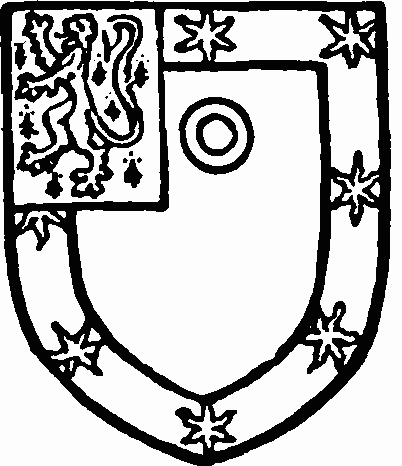
St. John's College, Oxford, Gules a border sable charged with stars or and a quarter ermine with a lion sable therein and the difference of a ring or.
QUARRELSTEAD (Quarelstet, xv cent.; Quarrelles alias Qurrelsted, xvi–xvii cent.). The demesnes of Roger Quarel, deceased, in Appleton, are mentioned in February 1400–1. (fn. 99) In 1432 Stephen Frenshe and John Feriby granted to William Ludlow and other feoffees 'the manor of Appleton called Quarelstede,' which they had by grant of Sir Thomas Wykham of Oxfordshire, kt., and William his son. (fn. 100) In 1437 the other feoffees released their right to William Ludlow, (fn. 101) and his family apparently remained in possession until 1576 when the manor was conveyed by John Ludlow to Nicholas Melton (fn. 102) of Nately Scures, Hampshire; he settled the remainder after his own death on Francis Little of Abingdon, who married his daughter Anne (and had a son and heir Francis) on condition that his son-in-law portioned the other children. Nicholas died in 1616, and Francis proceeded to sell the estate to Richard Whitwick, clerk, disguising the fact that it was encumbered. This led to a lawsuit, (fn. 103) after which no mention of the manor has been found. The name has now disappeared.
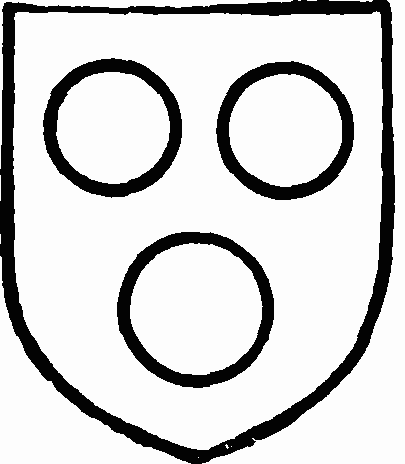
Bessels. Argent three roundles gules.
William Bessels of Bessels Leigh (q.v.) on his death in 1515, held the manor or capital messuage of TYNTEYNS (Tyntons, xvii cent.) of Thomas Denton. (fn. 104) It passed with Bessels Leigh to the Fettiplaces, (fn. 105) who acquired Appleton in 1564, and it then descended with Appleton (q.v.) until sold by Mr. Cooke, in the latter part of the 18th century, to Mr. Sansum (fn. 106); he, in 1833, sold part of the estate with the house to Richard Richards, whose cousin, Mr. Joseph Cowderoy Richards, is the present owner. Sansum alienated other portions to the Southbys. (fn. 107)
Church
The church of ST. LAURENCE consists of a chancel 28 ft. by 15 ft. with north chapel making a total width of 30 ft., nave 44 ft. 4 in. by 14 ft. 9 in. with north aisle making a total width of 31 ft., west tower and north and south porches. These measurements are all internal.
The development of the building is rather obscure, but the nave is probably of 12th-century date, the north arcade dating from the late in that century. The chancel was perhaps rebuilt in the 13th century, but the door is the only detail of that period. Various windows were inserted in the 15th century, and the west tower was then built. The south porch is an early 16th-century addition. The north aisle was rebuilt and the north chapel added, probably in the 17th century, the north aisle being ceiled about 1612. Both appear to have been subsequently altered, and the north porch was probably added early in the 18th century. The church has been slightly restored in modern times.
The chancel has a restored east window of three lights and of 14th-century character. In the north wall is an arcade of four bays opening into the north chapel. The semicircular wainscoted arches are of the 18th century and rest on square piers with moulded capitals and bases. These inclose circular wooden posts of earlier date. In the south wall is a pointed priest's doorway, perhaps of 13th-century date, and further west is a square-headed early 16thcentury window of two plain lights. The chancel arch is modern and the wagon roof is ceiled. The north chapel has a two-light east and a three-light north window, both of plain square-headed lights.
The nave has a north arcade of four bays and of about 1190 to 1200. The pointed arches are of a single chamfered order and rest on cylindrical piers with moulded bases and capitals of deep projection. The first capital has good carved foliage volutes and the second has similar volutes and interlacing bands ornamented with nail-heads; the third is moulded, and all have square abaci. The responds are square, the eastern having a scalloped capital partly restored. At the east end of the south wall is a two-light 13th-century window with a modern head and mullion. The plain pointed south doorway is of the same date, and further west is a square-headed 15th-century window of two lights. The trussed rafter roof of the nave is apparently of 15th-century date. The north aisle was apparently widened when it was rebuilt, but traces of the original west wall remain. It has two three-light windows in the north wall and another at the west end, all square-headed and with plain lights. The north doorway has a four-centred head, perhaps earlier work re-used. The roofs of the aisle and north chapel are both of wagon form and ceiled.
The west tower is of three stages with a square turret at the south-east angle rising to the base of the third stage, and an embattled parapet. The blocked tower arch is of the 15th century; it is pointed and of two chamfered orders, the inner resting on brackets, that on the south having a head corbel. In the west wall is a pointed two-light window of doubtful date, and below it is a four-centred 15thcentury door with quatrefoil panelled spandrels. The second stage has a square-headed 15th-century light in the south wall, and the belfry has a two-light square-headed window of the same date in each face. On the top of the tower is a wooden louvred lantern. The north porch was apparently built about 1700 and has a four-centred outer archway. The south porch has a four-centred outer archway with a small canopied niche in the gable above it and plain oak double doors of early 16th-century date. Each side wall has a loop light and the roof is of stone slabs.
The early 17th-century communion table is of oak with turned legs, and the early 18th-century rails with turned balusters and square fluted posts now stand at the entrance of the chancel. The font has a slightly tapering cylindrical bowl of the 12th century and stands on a circular base with spiral flutings, of which only a part is ancient. The octagonal cover, of steeple form, is of late 17th-century date. Two old open benches remain in the nave, and in the chapel is a small quantity of Jacobean panelling.
On the south of the altar is a handsome wall monument to John Fettiplace (1593), with a long Latin inscription. The freestone recumbent effigy is represented in armour, and over it is a flat canopy with an entablature resting on fluted Corinthian columns; above it are obelisks and an achievement of the Fettiplace arms quartering Bessels and Leigh. The back of the tomb is enriched with elaborate strapwork, cherubim, &c., and the whole has been whitewashed. In the north chapel are a number of tablets to members of the Southby family, including Robert Southby (1717). On the chancel floor is a shroud brass to John Goudrington (1518). On the soffit of the first arch in the nave is a painted collect, giving thanks for 'this good gift given by the hands of Sir Richard Fettiplace.' In the first window of the north aisle of the nave are three glass shields, one of Golafre, the other two with uncertain heraldry.
There are ten bells: the treble of 1875, the second, third, fourth, fifth, sixth and seventh by Mears of London, all given by J. Southby in 1817, and one of them recently recast; the eighth recast 1874; the ninth and tenor given by F. E. Robinson in 1861.
The plate includes a cup (London, 1659) inscribed 'Appelton'; a cover paten (London, 1728); an almsdish (London, 1683) inscribed 'The gift of Mrs. Anne Southby to the use of the church of Appleton 1683'; and a plated flagon.
The registers before 1812 are as follows: (i) mixed entries 1569 to 1709; (ii) mixed entries 1710 to 1801, marriages to 1752 only; (iii) marriages 1754 to 1812; (iv) baptisms and burials 1802 to 1812.
Advowson
The advowson of the rectory of Appleton is mentioned for the first time in 1267, (fn. 108) and followed the descent of the manor (q.v.) until 1638, when a moiety was sold by William Lenthall to Magdalen College, Oxford. (fn. 109) The president and fellows afterwards became sole patrons, (fn. 110) and still hold the advowson.
In 1291 the abbeys of Bec, Eynsham and Abingdon had each a portion in the church. (fn. 111) Abingdon Abbey received confirmation from the archbishop in 1390 of its right to 18d. from this church, an amount confirmed by the pope in February 1400–1. (fn. 112)
Charities
For the educational foundations of Sir Richard Fettiplace, deed 1604, and Thomas Lane, will 1709, see the article on schools. (fn. 113) The trust estates consist of the Common Close containing 4 a. 2 r. 38 p., let at £10 a year, and a meadow known as Thames Close containing 3 a. 1 r. 30 p., let at £3 10s. yearly. The net income is applied in aid of the Sunday school.
Charity of Sir Richard Fettiplace, founded by deed 1611, for distribution of bread and relief of the poor. The property consists of a farm-house and orchard containing 3 r. 30 p. and a garden containing 1 rood, let at £15 yearly; an allotment of 11 a. 2 r. under the Appleton Inclosure Act, 1831, let at £10 10s. yearly; annuities amounting together to £1 18s. 4d. issuing out of lands in Eaton and Appleton; an annuity of 8s. paid out of the Bampton Poor Estate, and £101 19s. 3d. consols, with the official trustees, arising from sale in 1874 of woodland, producing £2 11s. yearly. The annuities are applied in the distribution of bread every other Sunday in the church to fourteen aged poor persons, a sum of 1s. 4d. being paid to the clerk. A moiety of the remaining income of the charity is appropriated under the authority of an order of the Charity Commissioners, of 19 April 1904, to a night school, by the title of Fettiplace's Foundation and Advancement, the other moiety being divided among poor cottagers at Christmas time.
Church and poor money.—By a deed dated 9 March 1611 a messuage, a close and two cottages were conveyed to trustees in consideration of £30 in the hands of the churchwardens for charitable purposes.
On the inclosure 5 a. Or. 36 p. were allotted to this charity. There are now five cottages on the church close above referred to, let at £15 10s. yearly. The inclosure land is let in allotments, and produces about £9 yearly. The net income is applied for church purposes.
In 1717 Robert Southby, by his will, gave an annuity of £2 to the poor, in two payments on Ash Wednesday and Good Friday, charged upon testator's property known as 'Staff and Water,' being 2 acres of pasture in Moreton Mead. The distribution is made in sixpences to poor persons attending church on those days.
In 1723 Samuel Cripps, D.D., by his will, charged his lands in St. Giles's Fields with £12 yearly, one moiety thereof for the benefit of the poor of Appleton, and the other moiety for the poor of St. Michael's, Oxford. The charity is regulated by a scheme of the Charity Commissioners of 28 October 1887, the £6 for Appleton being applied in providing three gowns for three women and three coats for three men, members of the Church of England.
The Poor's Lands consist of two allotments under the inclosure in 1831, containing respectively 3 a. 1 r. 28 p. and 2 r. 30 p., producing £110s. yearly, which is divided at Christmas among the cottagers.
For the charity of William Sellwood for providing foul-weather jackets see under parish of Bessels Leigh, Hormer Hundred.
In 1856 Richard Richards, by his will proved in the Archdeaconry Court of Berkshire 18 October, bequeathed £300, £3 of the yearly income to be paid to the schoolmaster for teaching one boy, and the residue to be distributed on St. Thomas's Day among poor members of the Established Church. The legacy is now represented by £299 4s. 3d. Metropolitan 3 per cent. stock with the official trustees, producing £8 19s. 6d. yearly, of which £3 is applied for the benefit of the National school, under the title of the Richard Richards Educational Foundation, the residue being applied for the benefit of the poor as directed by the testator.
